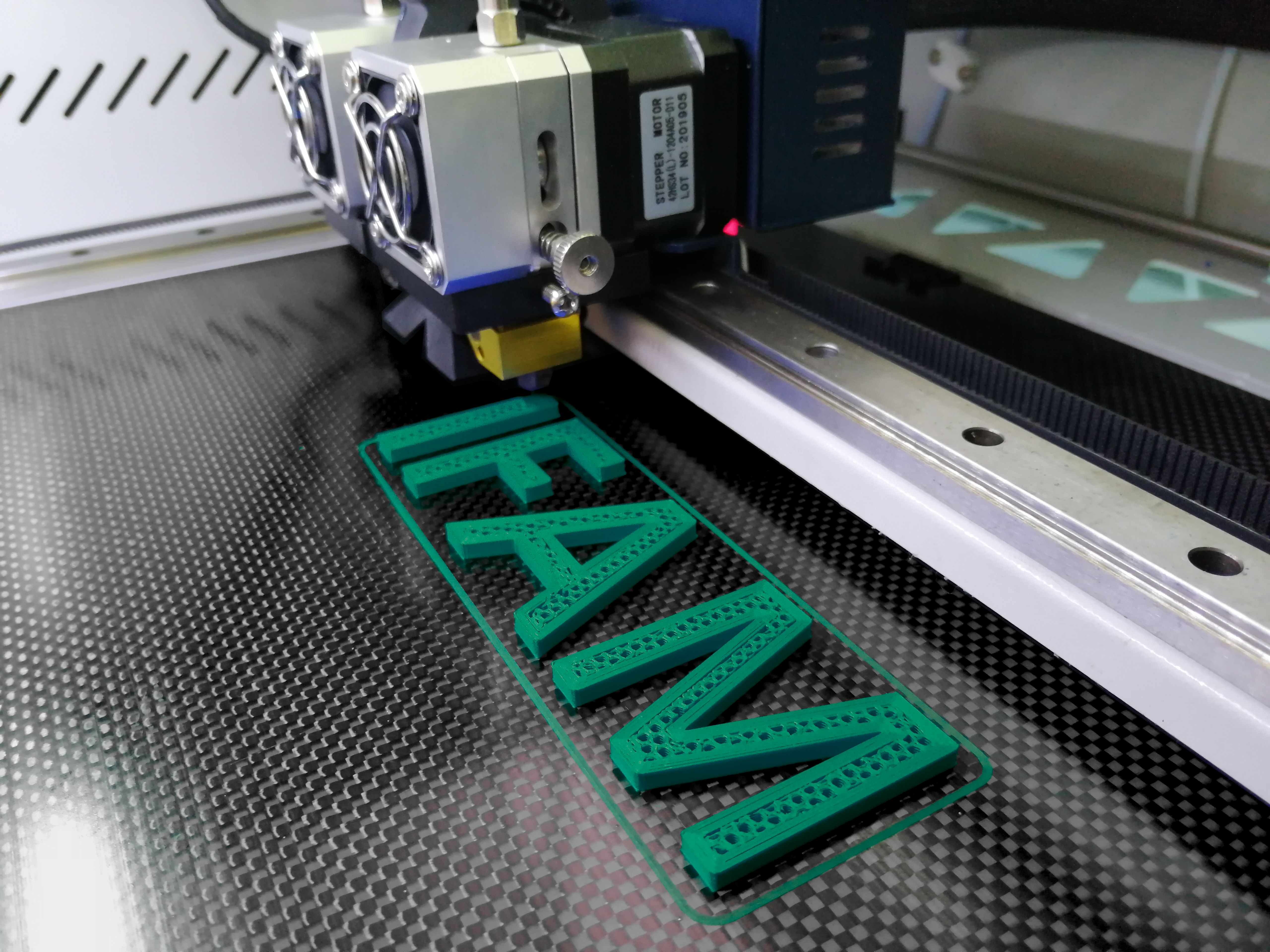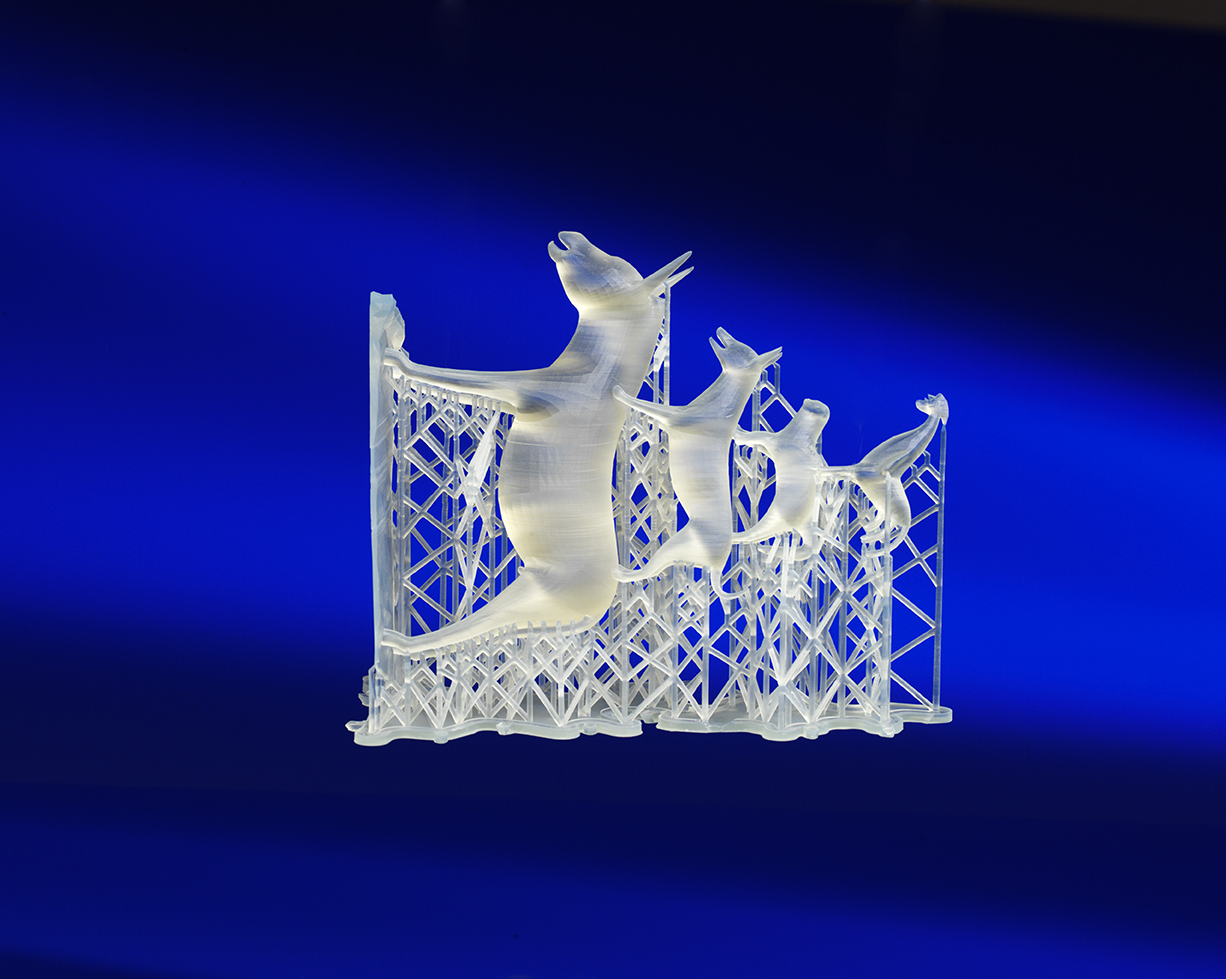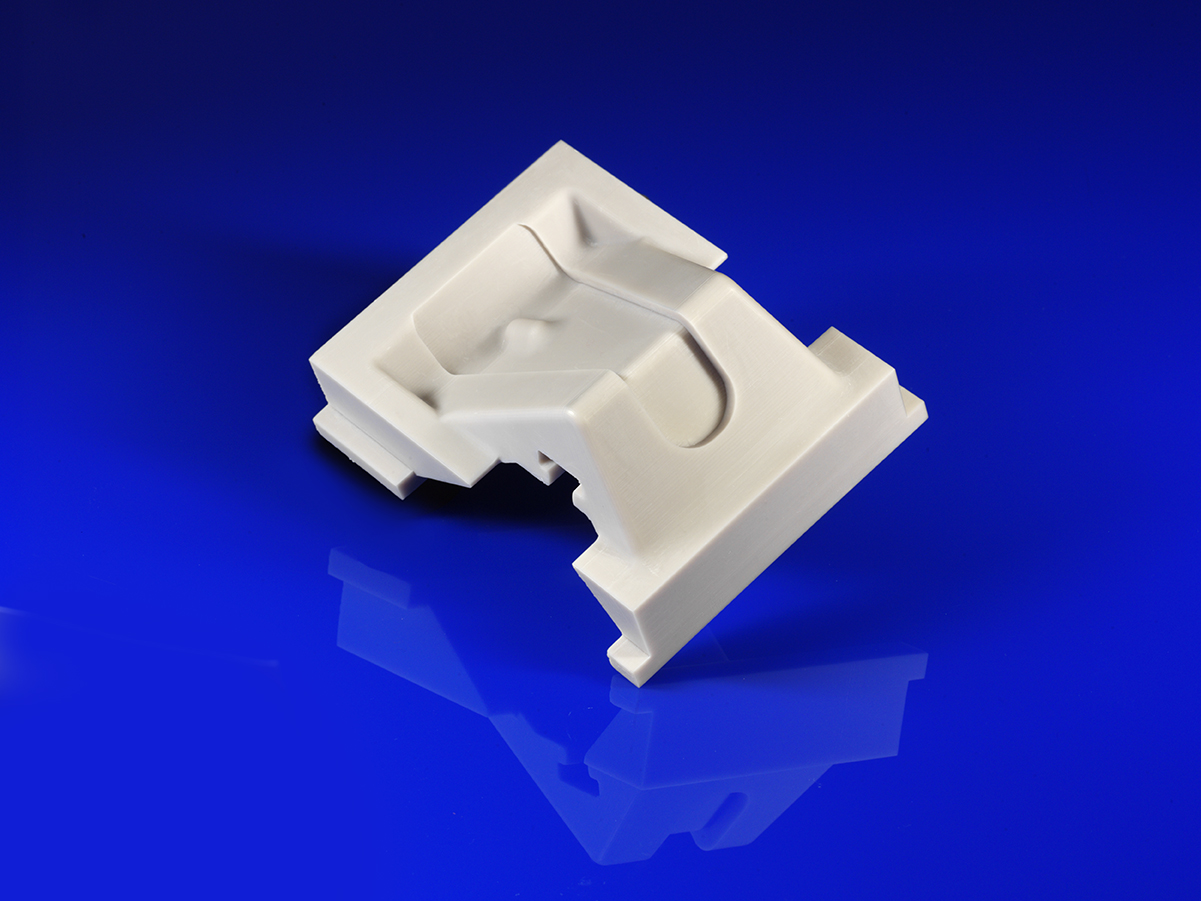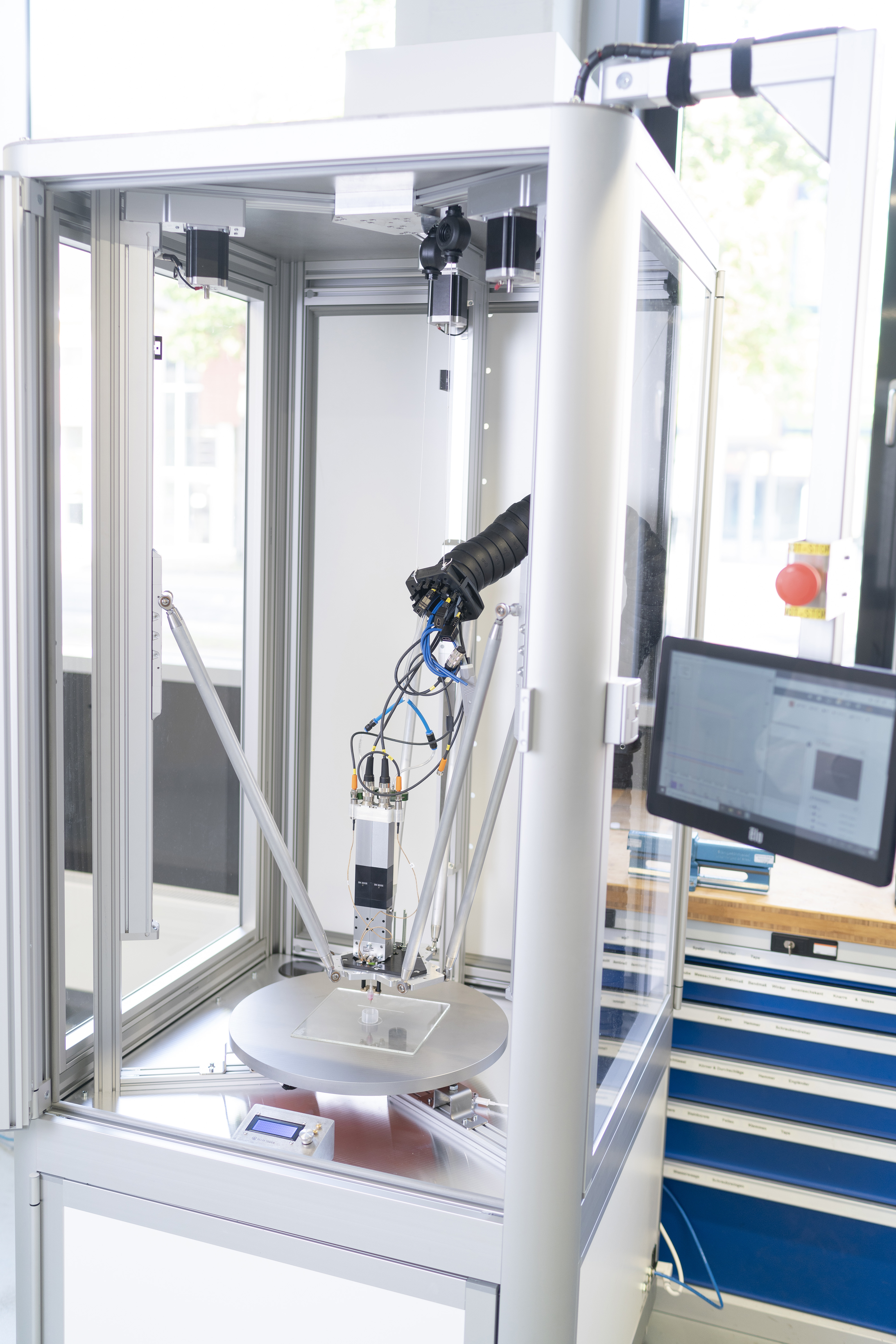Material development for the additive manufacturing of plastic components
3D printing is one of the most sought-after manufacturing processes today. The technology is characterized by enormous geometric flexibility and low material consumption. The process can be used to produce high-quality prototypes in a very short time. However, additive manufacturing is also becoming increasingly interesting for industrial series production. Components can be customized and manufactured directly from the CAD model with little manual effort, making the process interesting for dental technology, the aerospace industry, and toolmaking, for example. With the increasing spread and further development of additive manufacturing, the demand for special materials is also growing. At Fraunhofer IFAM, a wide variety of reactive resin formulations are being developed for 3D printing. In addition to the final component properties, the focus of the work is on the match between printer and material.
3D Printing: We formulate the right material for your application
In additive manufacturing, a component is built up layer by layer using a three-dimensional CAD model. Depending on the desired objective, different processes and materials are used. In addition to thermoplastics, reactive resin systems in particular are used for 3D printing, as these result in highly durable, chemically cross-linked components. They are applied as a liquid in various additive manufacturing processes such as vat photopolymerization (VPP), binder jetting (BJT) and liquid additive manufacturing (LAM) and cure reactively in the presence of a trigger (ultraviolet (UV) radiation, heat or moisture) to form a solid 3D component. Even when processing filaments in the Fused Filament Fabrication (FFF) process, the use of thermoplastic reactive resins is possible. In this case, the crosslinking reaction results in duromer components that excel in terms of their thermomechanical properties and media resistance.
It is crucial for the successful production of components that the printer and the material are perfectly matched. The experts at our institute develop specific resins for different generative manufacturing processes. The main focus is on:
- the development of formulations based on epoxides, acrylates, polyurethanes and silicones
- the adjustment of individual rheological and thermomechanical properties
- the coordination between the reactivity of the formulation and the process parameters for the printing process
Use of various additive manufacturing processes for optimum component properties
Whether temperature-resistant, flexible or rigid, 3D printing can be used to realize a wide variety of component properties. In order to serve the widest possible range, different processes are used at our institute:
Vat photopolymerization
In Vat photopolymerization, objects are created layer by layer by selectively curing liquid resin. UV radiation with a wavelength of 385 nm or 405 nm is usually used for this purpose. The best-known process in this group is stereolithography (SLA), in which a UV laser is used to cure the individual layers.
In printing processes using Digital Light Processing (DLP) and Liquid Crystal Display (LCD) techniques, complete images are exposed in each case, whereby all dots of a layer are cured simultaneously. Acrylics, methacrylates and epoxy resins with corresponding photoinitiators are used as light-curing resins in the above-mentioned processes.
This additive manufacturing process is characterized by high accuracy, very good surface quality and physiological compatibility. It is therefore widely used in medical products, such as in the dental industry. However, it is also used for other areas where high precision is required, such as mold making for investment casting or polymer injection molding.
Our offer: Formulation of UV resins
- Formulations based on (meth)acrylates and epoxy resins
- Adjustment of desired material properties (impact strength, thermal conductivity, temperature resistance, etc.)
Fused Filament Fabrication
3D printers based on Fused Filament Fabrication technology (FFF, FDM) are widely used in the field of additive manufacturing. In this process, a thermoplastic filament is melted in a heated print head and applied layer by layer to a build platform. In this way, complex three-dimensional components can be created from a CAD file with little effort. FFF is mainly used for the production of prototypes or production aids such as holders or drilling templates, but can also be found in series production. Different types of thermoplastics can be used as filament for the process. However, standard materials such as polylactide (PLA) or acrylonitrile butadiene styrene (ABS) cannot be used to produce durable components that can withstand long-term stress. Therefore, we are working on new materials that lead to duromer products using the FFF processes.
Our offer: Formulation development for FFF
- Reactive filament materials for the production of cross-linked, temperature and media resistant components
- Formulations based on epoxy resins and polyurethanes
Binder Jetting
The binder jetting process (BJT) is an additive manufacturing process in which a binder (usually inkjet) is applied to a powdered starting material to selectively bond powder areas. A 3D component is created by alternately applying multiple layers of powder and binder. A wide variety of powders, such as sand, metal or polymer powders, can be used in the process. In addition, no support material is required, as the component is held by the powder during the printing process. The process has a wide range of applications, such as for the production of metal parts and models for the automotive industry and the architectural sector.
Our offer: Research and development on 1K and 2K systems
- 1K binders, which can be activated by UV radiation, for example
- 2K binders, where resin and hardener are applied one after the other or simultaneously
Liquid Additive Manufacturing
The Liquid Additive Manufacturing process is based on the application of liquid or pasty reactive polymers. In this process, the component is built up in layers, similar to the FFF process. It is possible to use one- or two-component resin systems. Curing takes place by heat (e.g. infrared radiation), by UV radiation or by reaction with atmospheric moisture. LAM is suitable for the production of flexible materials such as seals or components for the orthopedic and medical fields.
Our offer: Formulation development for LAM
- 1K-systems based on polyurethanes and acrylates, curing by UV-radiation or air humidity
- 2K systems based on polyurethanes, epoxy resins and silicones
Your contact person on the subject of 3D printing for resin systems:
Andreas Lühring works as a project manager and development engineer at Fraunhofer IFAM in the "Adhesives and Polymer Chemistry" department and is responsible for projects in the areas of "Additive Manufacturing" and "Adhesive Formulations". Together with his colleagues, he develops reactive formulations for new polymeric materials in industrial and publicly funded projects. These polymeric materials are used in a wide variety of industries such as medical technology, automotive and aerospace. Together with Prof. Dr. Andreas Hartwig and Dr. Matthias Popp from Fraunhofer IFAM, Andreas Lühring was awarded the Joseph von Fraunhofer Prize in 2014 for work on "Bonding with pre-applied adhesives".
 Fraunhofer Institute for Manufacturing Technology and Advanced Materials IFAM
Fraunhofer Institute for Manufacturing Technology and Advanced Materials IFAM


